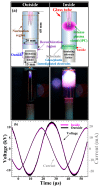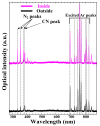Conductive Polymer Synthesis with Single-Crystallinity via a Novel Plasma Polymerization Technique for Gas Sensor Applications
- PMID: 28773932
- PMCID: PMC5456590
- DOI: 10.3390/ma9100812
Conductive Polymer Synthesis with Single-Crystallinity via a Novel Plasma Polymerization Technique for Gas Sensor Applications
Abstract
This study proposes a new nanostructured conductive polymer synthesis method that can grow the single-crystalline high-density plasma-polymerized nanoparticle structures by enhancing the sufficient nucleation and fragmentation of the pyrrole monomer using a novel atmospheric pressure plasma jet (APPJ) technique. Transmission electron microscopy (TEM), Fourier transform infrared spectroscopy (FT-IR), X-ray photoelectron spectroscopy (XPS), and field emission scanning electron microscopy (FE-SEM) results show that the plasma-polymerized pyrrole (pPPy) nanoparticles have a fast deposition rate of 0.93 µm·min-1 under a room-temperature process and have single-crystalline characteristics with porous properties. In addition, the single-crystalline high-density pPPy nanoparticle structures were successfully synthesized on the glass, plastic, and interdigitated gas sensor electrode substrates using a novel plasma polymerization technique at room temperature. To check the suitability of the active layer for the fabrication of electrochemical toxic gas sensors, the resistance variations of the pPPy nanoparticles grown on the interdigitated gas sensor electrodes were examined by doping with iodine. As a result, the proposed APPJ device could obtain the high-density and ultra-fast single-crystalline pPPy thin films for various gas sensor applications. This work will contribute to the design of highly sensitive gas sensors adopting the novel plasma-polymerized conductive polymer as new active layer.
Keywords: atmospheric pressure plasma; gas sensor; iodine doping; plasma-polymerized pyrrole; single-crystalline.
Conflict of interest statement
The authors declare no conflict of interest.
Figures







Similar articles
-
Ultrafast Room Temperature Synthesis of Porous Polythiophene via Atmospheric Pressure Plasma Polymerization Technique and Its Application to NO2 Gas Sensors.Polymers (Basel). 2021 May 28;13(11):1783. doi: 10.3390/polym13111783. Polymers (Basel). 2021. PMID: 34071654 Free PMC article.
-
Atmospheric Pressure Plasma Polymerization Synthesis and Characterization of Polyaniline Films Doped with and without Iodine.Materials (Basel). 2017 Nov 6;10(11):1272. doi: 10.3390/ma10111272. Materials (Basel). 2017. PMID: 29113129 Free PMC article.
-
Synthesis and Characterization of Nanofibrous Polyaniline Thin Film Prepared by Novel Atmospheric Pressure Plasma Polymerization Technique.Materials (Basel). 2016 Jan 11;9(1):39. doi: 10.3390/ma9010039. Materials (Basel). 2016. PMID: 28787838 Free PMC article.
-
A Review of Plasma Synthesis Methods for Polymer Films and Nanoparticles under Atmospheric Pressure Conditions.Polymers (Basel). 2021 Jul 10;13(14):2267. doi: 10.3390/polym13142267. Polymers (Basel). 2021. PMID: 34301024 Free PMC article. Review.
-
Advances and challenges in the field of plasma polymer nanoparticles.Beilstein J Nanotechnol. 2017 Sep 25;8:2002-2014. doi: 10.3762/bjnano.8.200. eCollection 2017. Beilstein J Nanotechnol. 2017. PMID: 29046847 Free PMC article. Review.
Cited by
-
Plasma-aided direct printing of silver nanoparticle conductive structures on polydimethylsiloxane (PDMS) surfaces.Sci Rep. 2024 Dec 28;14(1):31154. doi: 10.1038/s41598-024-82439-y. Sci Rep. 2024. PMID: 39730889 Free PMC article.
-
Ultrafast Room Temperature Synthesis of Porous Polythiophene via Atmospheric Pressure Plasma Polymerization Technique and Its Application to NO2 Gas Sensors.Polymers (Basel). 2021 May 28;13(11):1783. doi: 10.3390/polym13111783. Polymers (Basel). 2021. PMID: 34071654 Free PMC article.
-
Structure and Dielectric Properties of Poly(vinylidenefluoride-co-trifluoroethylene) Copolymer Thin Films Using Atmospheric Pressure Plasma Deposition for Piezoelectric Nanogenerator.Nanomaterials (Basel). 2023 May 22;13(10):1698. doi: 10.3390/nano13101698. Nanomaterials (Basel). 2023. PMID: 37242113 Free PMC article.
-
In-Liquid Plasma Process for Size- and Shape-Controlled Synthesis of Silver Nanoparticles by Controlling Gas Bubbles in Water.Materials (Basel). 2018 May 25;11(6):891. doi: 10.3390/ma11060891. Materials (Basel). 2018. PMID: 29799512 Free PMC article.
-
Fabrication of Conjugated Conducting Polymers by Chemical Vapor Deposition (CVD) Method.Nanomaterials (Basel). 2025 Mar 16;15(6):452. doi: 10.3390/nano15060452. Nanomaterials (Basel). 2025. PMID: 40137625 Free PMC article. Review.
References
-
- Khalil A., Kim J.J., Tuller H.L., Rutledge G.C., Hashaikeh R. Gas sensing behavior of electrospun nickel oxide nanofibers: Effect of morphology and microstructure. Sens. Actuators B Chem. 2016;227:54–64. doi: 10.1016/j.snb.2015.12.012. - DOI
-
- Zanettini S., Dayen J.F., Etrillard C., Leclerc N., Kamalakar M.V., Doudin B. Magnetoconductance anisotropy of a polymer thin film at the onset of metallicity. Appl. Phys. Lett. 2015;106:063303. doi: 10.1063/1.4908526. - DOI
-
- Yoon H., Jang J. Conducting-polymer nanomaterials for high-performance sensor applications: Issues and challenges. Adv. Funct. Mater. 2009;19:1567–1576. doi: 10.1002/adfm.200801141. - DOI
-
- Bai H., Shi G. Gas sensors based on conducting polymers. Sensors. 2007;7:267–307. doi: 10.3390/s7030267. - DOI
LinkOut - more resources
Full Text Sources
Other Literature Sources
Research Materials
Miscellaneous

